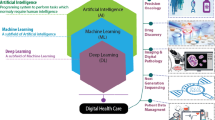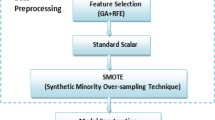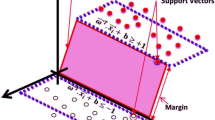Abstract
Forever and a day, breast cancer has caused significant negative impacts on the quality of lives of number of women, more often than not turning into a fatal disease. The growth in the number of such cases has constantly been a major concern for the community as well as medical experts. To prevent irreversible damages caused by the disease, early identification of breast cancer is essential. Various researches and techniques have been devised in the past as an attempt to achieve this task with appreciable accuracy. As an advancement to these pre-existing algorithms and methods, we have devised a model by exploiting the techniques of nature-inspired metaheuristics in order to efficiently detect breast cancer at an early stage while maintaining acceptable levels of accuracy. In this paper, we propose a hybrid model, namely “hybrid artificial bee colony and black hole with genetic operators (GBHABC)”, for the early detection of breast cancer. In the proposed model, we employed a support vector machine (SVM) ensemble technique, optimized using the proposed GBHABC model. This model combines the techniques of two major algorithms, namely artificial bee colony (ABC) and black hole (BH), guided through crossover and mutation genetic operators. Datasets from the well-known UCI breast cancer repository have been used to train the models and evaluate test result. For a fair and accurate evaluation of the model, a number of metrics have been examined including accuracy, sensitivity, specificity, F1-score and precision. An impeccable accuracy of 99.42% was obtained on the UCI dataset, clearly outperforming any literature in the same field.










Similar content being viewed by others
Data availability
The dataset generated and/or analysed during the current study is WBCD (machine learning repository).
References
Abdar M, Zomorodi-Moghadam M, Zhou X, Gururajan R, Tao X, Barua PD, Gururajan R (2020) A new nested ensemble technique for automated diagnosis of breast cancer. Pattern Recogn Lett 132:123–131. https://doi.org/10.1016/j.patrec.2018.11.004
Afolayan J, Adebiyi M, Arowolo M, Chakraborty A (2022, 06). Breast cancer detection using particle swarm optimization and decision tree machine learning technique. 61-83. https://doi.org/10.1007/978-981-16-8150-94
Barzaman K, Karami J, Zarei Z, Hosseinzadeh A, Kazemi MH, Moradi- Kalbolandi S, Farahmand L (2020) Breast cancer: biology, biomarkers, and treatments. Int Immunopharmacol 84:106535. https://doi.org/10.1016/j.intimp.2020.106535
Bhardwaj A, Tiwari A (2015) Breast cancer diagnosis using genetically optimized neural network model. Expert Syst Appl 42(10):4611–4620. https://doi.org/10.1016/j.eswa.2015.01.065
Boser BE, Guyon IM, Vapnik VN (1992) Training algorithm for optimal margin classifiers. In: Proceedings of the fifth annual acm workshop on computational learning theory, pp 144–152. Publ by ACM. https://doi.org/10.1145/130385.130401
Chen HL, Yang B, Liu J, Liu DY (2011) A support vector machine classifier with rough set-based feature selection for breast cancer diagnosis. Expert Syst Appl 38(7):9014–9022. https://doi.org/10.1016/j.eswa.2011.01.120
Chen HL, Yang B, Wang G, Wang SJ, Liu J, Liu DY (2012) Support vector machine based diagnostic system for breast cancer using swarm intelligence. J Med Syst 36(4):2505–2519. https://doi.org/10.1007/s10916-011-9723-0
Chen MJ, Wu WY-Y, Yen AM-F, Fann JC-Y, Chen SL, Chiu SY-H, Chiou ST (2016) Body mass index and breast cancer: analysis of a nation-wide population-based prospective cohort study on 1 393 985 Taiwanese women. Int J Obes 40(3):524–530. https://doi.org/10.1038/ijo.2015.205
Cortes C, Vapnik V (1995) Supportvector networks. Mach Learn 20(3):273–297. https://doi.org/10.1007/bf00994018
de Boer MC, Wörner EA, Verlaan D, van Leeuwen PA (2017) The mechanisms and effects of physical activity on breast cancer. Clin Breast Cancer 17(4):272–278. https://doi.org/10.1016/j.clbc.2017.01.006
Deeb H, Sarangi A, Mishra D, Sarangi SK (2021) Improved Black Hole optimization algorithm for data clustering. J King Saud Univ Comput Inf Sci. https://doi.org/10.1016/j.jksuci.2020.12.013
Dheeba J, Albert Singh N, Tamil Selvi S (2014) Computer-aided detection of breast cancer on mammograms: a swarm intelligence optimized wavelet neural network approach. J Biomed Inform 49:45–52. https://doi.org/10.1016/j.jbi.2014.01.010
Dora L, Agrawal S, Panda R, Abraham A (2017) Optimal breast cancer classification using Gauss-Newton representation based algorithm. Expert Syst Appl 85:134–145. https://doi.org/10.1016/j.eswa.2017.05.035
Dr. WIlliam H Wolberg (1992) UCI machine learning repository: breast cancer wisconsin (Original) Data Set
Gaitanidis A, Alevizakos M, Tsalikidis C, Tsaroucha A, Simopoulos C, Pitiakoudis M (2018) Refusal of cancer-directed surgery by breast cancer patients: risk factors and survival outcomes. Clin Breast Cancer 18(4):e469–e476. https://doi.org/10.1016/j.clbc.2017.07.010
Gerstl B, Sullivan E, Ives A, Saunders C, Wand H, Anazodo A (2018) Pregnancy outcomes after a breast cancer diagnosis: a systematic review and meta analysis. Clin Breast Cancer 18(1):e79–e88. https://doi.org/10.1016/j.clbc.2017.06.016
Goff SL, Danforth DN (2021) The role of immune cells in breast tissue and immunotherapy for the treatment of breast cancer. Clin Breast Cancer 21(1):e63–e73. https://doi.org/10.1016/j.clbc.2020.06.011
Gu J, Groot G, Boden C, Busch A, Holtslander L, Lim H (2018) Review of factors influencing women’s choice of mastectomy versus breast conserving therapy in early stage breast cancer: a systematic review. Clin Breast Cancer 18(4):e539–e554. https://doi.org/10.1016/j.clbc.2017.12.013
Hatamlou A (2013) Black hole: a new heuristic optimization approach for data clustering. Inf Sci 222:175–184. https://doi.org/10.1016/j.ins.2012.08.023
Hatamlou A (2018) Solving travelling salesman problem using black hole algorithm. Soft Comput 22(24):8167–8175. https://doi.org/10.1007/s00500-017-2760-y
Jayachitra S, Prasanth A (2020) Multi-feature analysis for automated brain stroke classification using weighted Gaussian Naive Baye’s classifier. J Circuits Syst Comput 30:2150178. https://doi.org/10.1142/S0218126621501784
Juanjuan L, Santa-Maria CA, Hongfang F, Lingcheng W, Pengcheng Z, Yuanbing X, Chuang C (2020) Patientreported outcomes of patients with breast cancer during the COVID-19 Outbreak in the epicenter of China: a cross-sectional survey study. Clin Breast Cancer 20(5):e651–e662. https://doi.org/10.1016/j.clbc.2020.06.003
Karabatak M (2015) A new classifier for breast cancer detection based on Naïve Bayesian. Measure J Int Measure Confed 72:32–36. https://doi.org/10.1016/j.measurement.2015.04.028
Karaboga D, Basturk B (2007) Artificial bee colony (ABC) optimization algorithm for solving constrained optimization problems. Lecture notes in computer science (including subseries lecture notes in artificial intelligence and lecture notes in bioinformatics, Vol 4529 LNAI, pp 789–798. Springer, Berlin, Heidelberg. https://doi.org/10.1007/978-3-540-72950-1-7
Kessous R, Davidson E, Meirovitz M, Sergienko R, Sheiner E (2017) Prepregnancy obesity: a risk factor for future development of ovarian and breast cancer. Eur J Cancer Prev 26(2):151–155. https://doi.org/10.1097/CEJ.0000000000000228
Kiyan T, Yildirim T (2004) Breast cancer diagnosis using statistical neural networks. Istanb Univ J Electr Electron Eng 4(2):1149–1153
Koo MM, von Wagner C, Abel GA, McPhail S, Rubin GP, Lyratzopoulos G (2017) Typical and atypical presenting symptoms of breast cancer and their associations with diagnostic intervals: evidence from a national audit of cancer diagnosis. Cancer Epidemiol 48:140–146. https://doi.org/10.1016/j.canep.2017.04.010
Krawczyk B, Filipczuk P (2014) Cytological image analysis with firefly nuclei detection and hybrid one-class classification decomposition. Eng Appl Artif Intell 31:126–135. https://doi.org/10.1016/j.engappai.2013.09.017
Kumar S, Datta D, Kumar Singh S, Azar AT, Vaidyanathan S (2015) Black hole algorithm and its applications. Stud Comput Intell 575:147–170. https://doi.org/10.1007/978-3-319-11017-2-7
Laamiri FZ, Bouayad A, Hasswane N, Ahid S, Mrabet M, Amina B (2015) Risk factors for breast cancer of different age groups: Moroccan data? Open J Obstet Gynecol 05(02):79–87. https://doi.org/10.4236/ojog.2015.52011
Lavanya S, Prasanth A, Jayachitra S, Shenbagarajan A (2021) A tuned classification approach for efficient heterogeneous fault diagnosis in IoT-enabled WSN applications. Measurement 183:109771
Li DC, Liu CW (2010) A class possibility based kernel to increase classification accuracy for small data sets using support vector machines. Expert Syst Appl 37(4):3104–3110. https://doi.org/10.1016/j.eswa.2009.09.019
Li Z, Yu L, Wang X, Yu H, Gao Y, Ren Y, Zhou X (2018) Diagnostic performance of mammographic texture analysis in the differential diagnosis of benign and malignant breast tumors. Clin Breast Cancer 18(4):e621–e627. https://doi.org/10.1016/j.clbc.2017.11.004
Littlestone N, Warmuth MK (1994) The weighted majority algorithm. Inf Comput 108(2):212–261. https://doi.org/10.1006/INCO.1994.1009
Luo J, Margolis KL, Wactawski-Wende J, Horn K, Messina C, Stefanick ML, Rohan TE (2011) Association of active and passivesmoking with risk of breast cancer among postmenopausal women: a prospective cohort study. BMJ 342(7796):536. https://doi.org/10.1136/bmj.d1016
Nahato KB, Harichandran KN, Arputharaj K (2015) Knowledge mining from clinical datasets using rough sets and backpropagation neural network. Comput Math Methods Med. https://doi.org/10.1155/2015/460189
Nazarian M, Dezfouli MA, Haronabadi A (2013) Classification of breast cancer samples through using the artificial bee colony algorithm. Int J Comput Appl Technol Res 2(5):522–525. https://doi.org/10.7753/ijcatr0205.1004
Nguyen AT, Shiao SL, McArthur HL (2021) Advances in combining radiation and immunotherapy in breast cancer. Clin Breast Cancer 21(2):143–152. https://doi.org/10.1016/j.clbc.2021.03.007
Nguyen T, Khosravi A, Creighton D, Nahavandi S (2015) Classification of healthcare data using genetic fuzzy logic system and wavelets. Expert Syst Appl 42(4):2184–2197. https://doi.org/10.1016/j.eswa.2014.10.027
Punitha S, Amuthan A, Joseph KS (2019) Enhanced monarchy butterfly optimization technique for effective breast cancer diagnosis. J Med Syst 43(7):1–14. https://doi.org/10.1007/s10916-019-1348-8
Sekar J, Aruchamy P, Sulaima Lebbe Abdul H, Mohammed AS, Khamuruddeen S (2022) An efficient clinical support system for heart disease prediction using TANFIS classifier. Comput Intell 38(2):610–640. https://doi.org/10.1111/coin.12487
Senapati MR, Mohanty AK, Dash S, Dash PK (2013) Local linear wavelet neural network for breast cancer recognition. Neural Comput Appl 22(1):125–131. https://doi.org/10.1007/s00521-011-0670-y
Shahbeig S, Helfroush MS, Rahideh A (2017) A fuzzy multi-objective hybrid TLBO-PSO approach to select the associated genes with breast cancer. Signal Process 131:58–65. https://doi.org/10.1016/j.sigpro.2016.07.035
Sheikhpour R, Sarram MA, Sheikhpour R (2016) Particle swarm optimization for bandwidth determination and feature selection of kernel density estimation based classifiers in diagnosis of breast cancer. Appl Soft Comput J 40:113–131. https://doi.org/10.1016/j.asoc.2015.10.005
Storn R, Price K (1997) Differential evolution-a simple and efficient heuristic for global optimization over continuous spaces. J Global Optim 11(4):341–359. https://doi.org/10.1023/A:1008202821328
Sung H, Ferlay J, Siegel RL, Laversanne M, Soerjomataram I, Jemal A, Bray F (2021) Global cancer statistics 2020: GLOBOCAN estimates of incidence and mortality worldwide for 36 cancers in 185 countries. CA Cancer J Clin 71(3):209–249. https://doi.org/10.3322/caac.21660
Tao D, Tang X, Wu X (2006) Asymmetric bagging and random subspace for support vector machines-based relevance feedback in image retrieval. IEEE Trans Pattern Anal Mach Intell 28(7):1088–1099. https://doi.org/10.1109/TPAMI.2006.134
Thawkar S, Sharma S, Khanna M, Kumar Singh L (2021) Breast cancer prediction using a hybrid method based on butterfly optimization algorithm and ant lion optimizer. Comput Biol Med 139:104968. https://doi.org/10.1016/j.compbiomed.2021.104968
Vieira R, Sánchez Tobar JS, Dardes R, Thuler LCS (2018) Alcohol consumption as a risk factor for breast cancer development: a case-control study in Brazil. Asian Pac J Cancer Prev 19(3):703–707. https://doi.org/10.22034/APJCP.2018.19.3.703
Waks AG, Winer EP (2019) Breast cancer treatment: a review. JAMA 321(3):288–300. https://doi.org/10.1001/jama.2018.19323
Wang H, Zheng B, Yoon SW, Ko HS (2018) A support vector machine-based ensemble algorithm for breast cancer diagnosis. Eur J Oper Res 267(2):687–699. https://doi.org/10.1016/j.ejor.2017.12.001
Wang M, Chen H (2020) Chaotic multi-swarm whale optimizer boosted support vector machine for medical diagnosis. Appl Comput J 88:105946. https://doi.org/10.1016/j.asoc.2019.105946
Wang Y, Wang N, Xu M, Yu J, Qin C, Luo X, Ni D (2020) Deeply-supervised networks with threshold loss for cancer detection in automated breast ultrasound. IEEE Trans Med Imag 39(4):866–876. https://doi.org/10.1109/TMI.2019.2936500
Wuniri Q, Huangfu W, Liu Y, Lin X, Liu L, Yu Z (2019) A generic-driven wrapper embedded with feature-type-aware hybrid bayesian classifier for breast cancer classification. IEEE Access 7:119931–119942. https://doi.org/10.1109/ACCESS.2019.2932505
Yeh WC, Chang WW, Chung YY (2009) A new hybrid approach for mining breast cancer pattern using discrete particle swarm optimization and statistical method. Expert Syst Appl 36(4):8204–8211. https://doi.org/10.1016/j.eswa.2008.10.004
Zarbakhsh P, Addeh A, Demirel H (2018) Early detection of breast cancer using optimized ANFIS and features selection. In: Proceedings-9th international conference on computational intelligence and communication networks, cicn 2017, Vol 2018-Janua, pp 39–42. Institute of Electrical and Electronics Engineers Inc. https://doi.org/10.1109/CICN.2017.8319352
Zheng B, Yoon SW, Lam SS (2014) Breast cancer diagnosis based on feature extraction using a hybrid of K-means and support vector machine algorithms. Expert Syst Appl 41(1):1476–1482. https://doi.org/10.1016/j.eswa.2013.08.044
Funding
The authors declare that no funds, grants or other support were received during the preparation of this manuscript.
Author information
Authors and Affiliations
Corresponding author
Ethics declarations
Conflict of interest
The authors declare that we have no conflict of interest.
Ethical approval
This article does not contain any studies with human participants performed by any of the authors.
Informed consent
This article does not contain any studies with human participants or animals performed by any of the authors.
Additional information
Publisher's Note
Springer Nature remains neutral with regard to jurisdictional claims in published maps and institutional affiliations.
Rights and permissions
Springer Nature or its licensor (e.g. a society or other partner) holds exclusive rights to this article under a publishing agreement with the author(s) or other rightsholder(s); author self-archiving of the accepted manuscript version of this article is solely governed by the terms of such publishing agreement and applicable law.
About this article
Cite this article
Singh, I., Srinivasa, K.G., Maurya, M. et al. Hybrid ABC and black hole algorithm with genetic operators optimized SVM ensemble based diagnosis of breast cancer. Pattern Anal Applic 26, 1771–1791 (2023). https://doi.org/10.1007/s10044-023-01203-6
Received:
Accepted:
Published:
Issue Date:
DOI: https://doi.org/10.1007/s10044-023-01203-6




